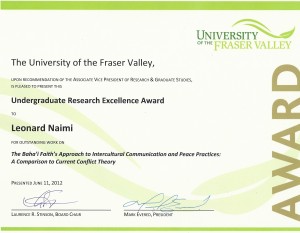My research into conflict theory has provided me with invaluable knowledge of how different cultures and religions approach and handle conflict. I look forward to implementing what I learned into my classroom.
In my final year of undergraduate studies I undertook a research project for my Communications minor. As a Baha’i I’ve been well aware of the persecution the Baha’is have faced throughout their existence in Iran. I personally know individuals who have been imprisoned and tortured. However, I had never viewed the actions Baha’is have taken in the face of conflict from the perspective of the non-adversarial approach, and in terms of intercultural communication. My particular interest in the subject of intercultural communication theory as it applies to the how Baha’is have approached conflict came about as a result of studying conflict theory in one of my communication classes and realizing that the frameworks we were studying didn’t seem to fully encompass Baha’i beliefs about peace and conflict.
My question was as follows: In what ways do the Baha’i Faith approaches to peace practices match and differ from existing conflict communication theory? Conflict management theory as it is currently taught in intercultural communication primarily focuses on the workplace and interpersonal conflict resolution models with some modification and theorizing related to cultural differences. The purpose of my inquiry was to better understand conflict theory in situations where there is ongoing and seemingly intransigent contexts that can lead to degradation, persecution, and genocide of cultural groups. I focused on comparing intercultural conflict and conflict resolution theory with documented Baha’i peace practices in two cases: Baha’is in Nazi Germany; and the Baha’i Institute of Higher Education (BIHE) in current day Iran.
Drawing from written sources about the two cases I defined the nature of 1) a particular conflict incident; 2) the response and/or result of that conflict; and, 3) the communication acts used by the Bahá’ís during the conflict. This categorization resulted in eight types of verbal and non-verbal communication acts. These eight types were then compared to the frameworks of the various conflict models. In particular three types of acts demonstrate the Bahá’í worldview not accounted for in the most common conflict models. These acts negotiate the dialectical tension between unity and diversity. First, obeying the government while working to transform social systems. Second, acting in ways that support peaceful relations while continuing to speak out about human rights; and third, focusing on maintaining ideals despite repeated and long-term experiences with reprisals from governments and individuals. The types of communication acts can offer valuable insights for peace practices.

Undergraduate research is invaluable for academic growth. One way to excel is by using resources like buy ib extended essay services. These can provide guidance and high-quality examples to help you structure and develop your research effectively. Utilizing such tools can significantly enhance your understanding and execution of complex research projects.